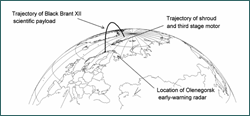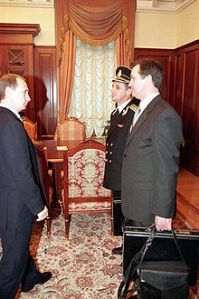Tales from the Nuclear Age
Copyright © 2011 by Charles Glassmire
__________________________________________________________
Jan. 17, 2011
Russian Football (part 2)
Russian radars were tracking an unknown missile launch off the Norwegian coast on the 25th of January 1995. Due to a possible Electromagnetic Pulse Attack (EMP) from a single warhead, the Russian Strategic Nuclear Forces were brought to a very high alert status, preparing for a counter-launch against the “enemy” nation. A possible US Submarine missile launch off the Norwegian coast was suspected, and the Russian defense began the countdown to counter-launch on warning (LOW). The three football suitcases (Chegets) received the war alert and Premier Yeltsin, for the first time in history, opened his suitcase and began actual preparations for nuclear war.
The Kazbek electronic network was activated by the alert, began the 10 minute countdown, and joined the three Chegets together in emergency teleconference. Defense Minister Pavel Grachev and chief of the General Staff Mikhail Kolesnikov, along with Yeltsin, began monitoring the path of this unknown missile. Due to the almost vertical ascent phase of the launch, their systems were unable to determine the actual ground track of the object. As the minutes ticked away, the missile reached altitude and rotated onto a northerly course, which could take it over the pole towards Moscow. Now the trio was considering whether to order the use of nuclear weapons against America. Any one of the three had the power to order a nuclear launch, without permission from any of the others.
Early that same morning, a team of Norwegian and American scientists were preparing to launch an interesting scientific experiment. They were based on the Norwegian island of andoya, which contained a sounding rocket range off the northwest coast of Norway. Mounted onto a four stage Black Brant XII rocket, scientific equipment was in place to monitor the Aurora Borealis and accompanying atmospheric conditions. The rocket was to pass over Svalbard on a northbound trajectory toward the pole, and eventually reach an altitude of 903 miles before plunging into the sea.
In preparation for the experiment, the scientific team had published notice of the launch times, day, date and coordinates in an international notification system to all aircraft, known as Notices to Airmen (NOTAMS). These notices are scrupulously examined by all aircraft navigators on a daily basis. It would be most unfortunate for an aircraft to fly over a sounding rocket launch pad at the moment of blast off. In addition, the Norwegian Diplomatic Corps had sent launch notices to some thirty countries, alerting them all to the time and location of the test. This notification specifically included the Russian government. (It was later determined this notification was never passed on to the Russian radar observers.)
As the rocket climbed for altitude, the Russian radar range at Olendgorsk detected the launch in its boost phase. Trajectory was  vertical and unclear, and the launch was marked as “unknown”. To the radar observers, the missile speed and flight pattern seemed similar to a submarine-launched Trident Ballistic Missile. A missile alert was forwarded up the chain of command to the general in charge of the Strategic Nuclear Forces (SNF). As the object reached peak altitude, 2nd and then 3rd stages dropped away, and could be interpreted as Multiple Re-entry Vehicles (MIRVs) approaching impact. As the clock ticked on, Yeltsin began scanning the “nuclear Keys” from the Cheget, and decided the Russian population should not be notified. A direct call was made to U.S. President Clinton. However Russian submarine commanders were ordered to prepare missiles for launch.
vertical and unclear, and the launch was marked as “unknown”. To the radar observers, the missile speed and flight pattern seemed similar to a submarine-launched Trident Ballistic Missile. A missile alert was forwarded up the chain of command to the general in charge of the Strategic Nuclear Forces (SNF). As the object reached peak altitude, 2nd and then 3rd stages dropped away, and could be interpreted as Multiple Re-entry Vehicles (MIRVs) approaching impact. As the clock ticked on, Yeltsin began scanning the “nuclear Keys” from the Cheget, and decided the Russian population should not be notified. A direct call was made to U.S. President Clinton. However Russian submarine commanders were ordered to prepare missiles for launch.
Major Maksim Sjingarkin retired from the Strategic Nuclear Forces in 2000. He was later interviewed on Norwegian Television Channel TV2, and, being present in the room at the time, gives some insight as to what happened next. He stated the world came very close to nuclear war at that moment, and noted one Russian scenario for nuclear war has a nuclear strike originating around Norway from a submarine. He says:
“Yeltsin had opened the briefcase, the keys were put in place, and … at the same time missiles were prepared to launch… Yeltsin literally sat there with his finger on the trigger for awhile, considering whether to launch…”
Sjingarkin said his fellow officers hesitated to ready the Russian missiles while the Norwegian rocket was still in flight and had not impacted the Homeland. When ordered to prepare the missiles they faced such a serious moralistic dilemma that they were simply unable to follow orders.
Then, at about eight minutes into the countdown, the triumvirate decided the incident was not a threat, and the entire system alert status was de-escalated downward some two minutes before the launch deadline! The rocket plunged into the ocean near Spitsbergen as planned, after a 24 minute flight.
Bruce Blair, western expert on Russian war systems was recently asked about this incident. He observed:
“…What is generally true about the Russian situation is that their early warning and command systems have fallen on hard times, and they are deteriorating in physical respects. There are holes in the radar and satellite constellations [due to loss of the peripheral buffer nations around the Soviet Union – ed]. Russia has almost no ability to monitor the oceans from space now, so they rely heavily on ground radars, and the ground radars are not being maintained properly. The crews that operate them are not as proficient as they once were; their morale is not as high. In every sense of the word, the Russian early warning and command system is suffering. And that’s a trend that is almost certain to produce more false alarms in the future…”
(to be continued …)

